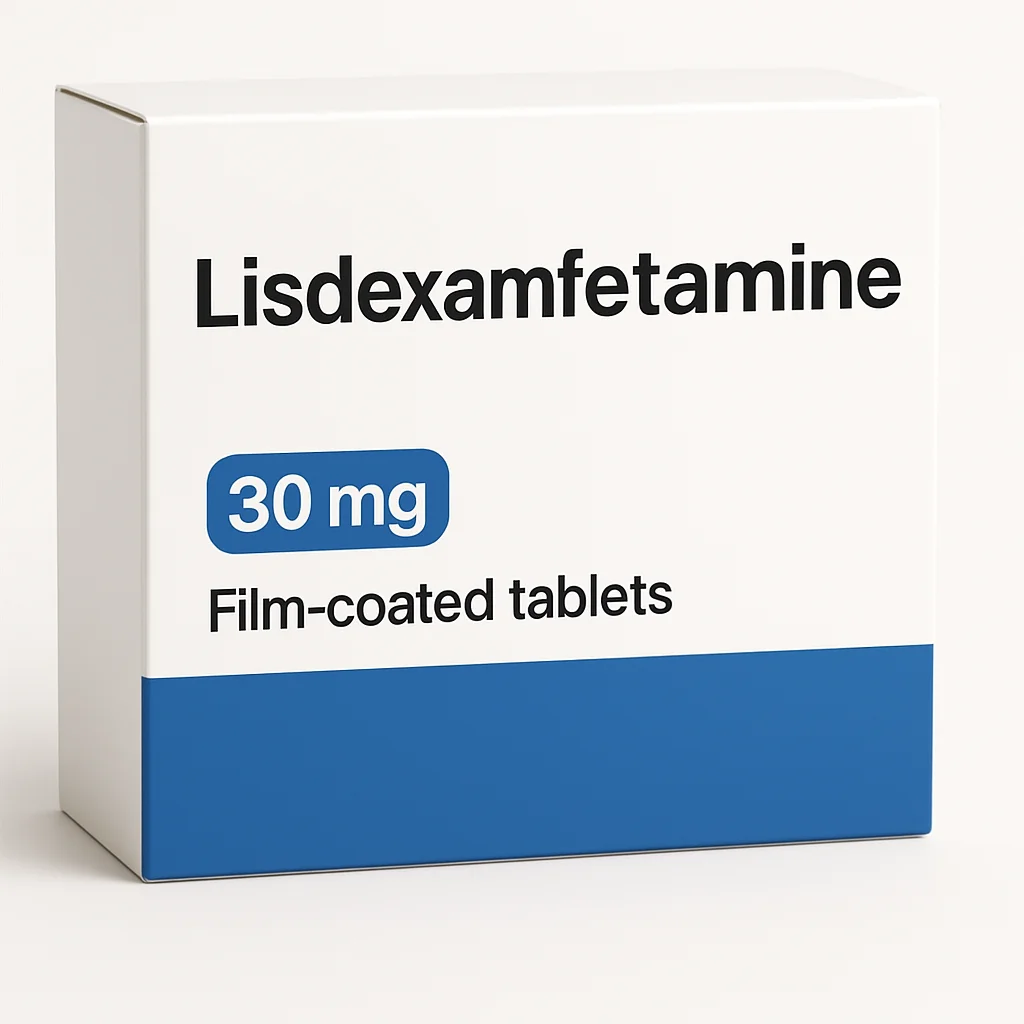Free UK shipping
Results in under 14 days
UK lab
10% Off All Tests - Autumn 2025
Introduction to Lisdexamfetamine
Attention Deficit Hyperactivity Disorder (ADHD) is increasingly recognised as a neurodevelopmental condition involving both genetic and neurochemical factors.
Heritability is high, estimated at 60–90%, with differences seen across several levels of brain organisation, particularly in areas of the prefrontal cortex that regulate attention, motivation, and reward (6). These regions rely heavily on the neurotransmitters dopamine and noradrenaline, which are often imbalanced in ADHD (6).
Lisdexamfetamine (LDX) is a modern evolution of older amphetamine-based treatments such as dexamfetamine. It was designed to deliver the same active compound—dexamfetamine—but in a more controlled way. Lisdexamfetamine itself is inactive until it is converted inside red blood cells into dexamfetamine (18, 20).
This slower activation produces steadier levels of the medicine throughout the day and reduces the risk of sharp peaks and drops associated with immediate-release stimulants (17).
In the UK, lisdexamfetamine is a Schedule 2 Controlled Drug, prescribed only by specialists with regular monitoring (12).

Considerations for Patients Taking Lisdexamfetamine
Lisdexamfetamine and dexamfetamine share a common goal: to increase the brain’s levels of dopamine and noradrenaline, improving focus and behavioural control (2, 6, 11). However, lisdexamfetamine achieves this through a more gradual process, leading to a gentler onset and offset of action.
Because of its design, lisdexamfetamine often provides smoother symptom control and fewer “crash” effects later in the day (17). It also has a lower potential for abuse than older stimulants (17, 18).
Abuse Potential
Although amphetamines have a history of misuse, the abuse potential of lisdexamfetamine in ADHD treatment is very low (17). This is because:
-
The medicine is a prodrug—it must first be converted in the body to dexamfetamine before it becomes active.
-
This conversion occurs gradually inside red blood cells, preventing rapid increases in dopamine.
-
It cannot be misused effectively via smoking, injection, or snorting, as it needs metabolic activation (17).
Some studies show conflicting data on abuse potential, but overall, lisdexamfetamine’s slow activation makes it safer and less reinforcing than short-acting amphetamines (17).
Cardiovascular Risk
Like other stimulants, lisdexamfetamine increases noradrenaline activity, which can lead to mild increases in heart rate and blood pressure (2). Although these effects are usually small, blood pressure and cardiovascular status should be monitored throughout treatment (4). It is contraindicated in people with structural heart abnormalities (18).
Psychiatric Considerations
Lisdexamfetamine influences areas of the brain involved in emotion and anxiety, particularly the amygdala (6). While most patients experience improved focus and emotional regulation, some may develop mild anxiety, irritability, or agitation. As with dexamfetamine, rare cases of psychotic symptoms or aggression have been reported (6). For those with a history of depression or psychiatric illness, careful supervision is recommended (18).
Explore PGX for Mental HealthWhy Have I Been Prescribed Lisdexamfetamine?
Treating ADHD
Lisdexamfetamine is prescribed for ADHD when a longer-acting, once-daily stimulant is preferred (12). It provides a steady release of active medication across the day, reducing the need for multiple doses. Treatment should be initiated by a specialist and reviewed regularly.
Dosing Lisdexamfetamine
How and when to take it
ADHD – Children (6–17 years)
Start at 20–30 mg once daily in the morning.
Increase in 10–20 mg steps each week if required.
Maximum dose: 70 mg/day.
If no response after one month, treatment should be discontinued.
ADHD – Adults
Start at 30 mg once daily.
Increase weekly by 20 mg if needed; maximum 70 mg/day.
Take in the morning to avoid sleep disturbance.
Lisdexamfetamine Side Effects
Most side effects are mild and lessen over time as the body adjusts.
The most common reactions include (18):
-
Loss of appetite
-
Insomnia
-
Headache
-
Dry mouth
-
Nausea or abdominal discomfort
-
Nervousness or mood changes
Less commonly, patients may experience elevated blood pressure, faster heartbeat, or irritability. Any persistent or severe side effects should be discussed with your prescribing clinician.
Explore PGX for Mental HealthHow Your Body and Genes Process Lisdexamfetamine
Because lisdexamfetamine is a prodrug, the rate of conversion rather than absorption determines its onset and duration. This process reduces the chance of rapid dopamine spikes, explaining its lower abuse potential (17).
People with lower CYP2D6 enzyme activity (poor metabolisers) may have higher blood levels of dexamfetamine, potentially increasing side effects such as insomnia or anxiety (21). Those with higher CYP2D6 activity (ultra-rapid metabolisers) may process the medicine faster, reducing its duration of benefit (21).
 Metabolism
Metabolism
Lisdexamfetamine has a distinct two-step metabolism:
-
Conversion in red blood cells – The medicine is enzymatically broken down into lysine and dexamfetamine (18, 20).
-
Liver metabolism of dexamfetamine – Once released, dexamfetamine undergoes further processing via CYP2D6, producing both active and inactive metabolites (21).
Personalising Lisdexamfetamine with Pharmacogenetics
Genetic variation in the CYP2D6 enzyme can affect how efficiently lisdexamfetamine is converted and metabolised. Pharmacogenomic (PGx) testing can identify whether you are a slow or fast metaboliser, helping your clinician tailor the starting dose and monitoring plan (21).
If your test shows reduced CYP2D6 activity, your doctor may start with a lower dose or observe more closely for side effects. Those with ultra-rapid metabolism may need dose adjustments or alternative medications.
Overall, lisdexamfetamine remains a well-established and well-tolerated ADHD treatment, with most patients experiencing significant improvement when carefully monitored (12, 18, 21).
Related Medications:
Other medicines used for ADHD include:
-
Dexamfetamine – the active form released by lisdexamfetamine; shorter-acting.
-
Methylphenidate – a stimulant with different mechanisms of action.
-
Atomoxetine – a non-stimulant that targets noradrenaline reuptake.
-
Viloxazine – a newer non-stimulant option for ADHD symptom control.
References
(1) NCBI Bookshelf: Amphetamine Overview; (2) PMC8063758; (3) SpringerLink: 10.1007/s43440-025-00763-0; (4) Frontiers in Pharmacology: 10.3389/fphar.2023.1208456; (5) PMC10876479; (6) SpringerLink: 10.1007/s40120-022-00392-2; (7) ScienceDirect: S0165178125002069; (8) MDPI Pharmaceuticals 5(2):9; (9) Nature Translational Psychiatry: s41398-023-02729-3; (10) PMC10564936; (11) PMC5167011; (12) British National Formulary (BNF); (13) PMC7039663; (14) PMC5789875; (15) PMC4857871; (16) PMC2515906; (17) PMC3666194; (18) Wiley: 10.1002/hup.2910; (19) NCBI Bookshelf: NBK507808; (20) PMC5594082; (21) Pharmacogenetics: CYP2D6 Genetic Variation Study (2024).